סמינר ארצי בפיזיקה גרעינית
Zoom: https://tau-ac-il.zoom.us/j/81042311058?pwd=orsMqYyg5f6aUkdLLrCjEqNdDy1ax7.1
PROGRAM:
12:30 - 13:00 - Refreshments
13:00 - 14:00 - Neutron-induced reactions in a high-density inertial confinement plasma at National Ignition Facility, Michael Paul. The Hebrew University of Jerusalem
Abstract:
The thermodynamical conditions and neutron density during the laser-induced implosion of a fusion capsule at the National Ignition Facility (NIF) constitute a unique stellar-like environment. We investigate neutron-induced reactions on Ar seeds added to a deuterium-tritium capsule, specifically the 40Ar(n,2n)39Ar(268 years) and 40Ar(n,γ)41Ar(110 min) reactions. We searched also for the production of 42Ar(33 years), a candidate for the observation of a rapid two-neutron capture on 40Ar, similar to the r-process occurring in stellar explosive nucleosynthesis. In parallel experiments, we measured for the first time (i) the cross-section of the 40Ar(n,2n)39Ar reaction by 14-MeV neutron activation at Helmholtz Zenter Dresden Rossendorf and (ii) the thermal neutron capture cross section of radioactive 41Ar at Institut Laue-Langevin. The long-lived 39,42Ar nuclides were analyzed by Noble Gas Accelerator Mass Spectrometry at Argonne National Laboratory. The 39,41,42Ar yields measured in the NIF implosion and investigation of the origin of observed 42Ar in particular will be presented.
14:00 - 14:30 - Coffee break
14:30 - 15:30 - Experimental program of nuclear Short-Range Correlations (SRC) studies at JINR (Russia), Maria Patsyuk, Joint Institute for Nuclear Research, JINR (Dubna, Russia)
Abstract:
Short-Range Correlations (SRC) are formed when a proton and neutron inside the nucleus instantly come close to each other. SRC phenomenon bridges the high-resolution mode operating in terms of quarks/gluons and a low-resolution picture when a nucleus consists of protons and neutrons (nucleons). Extensive electron scattering experiments held in the last decade have shown that SRCs have far-reaching impacts on many-body systems, the nucleon-nucleon interactions, and nuclear substructure. The SRC physics program at JINR utilizing ion beams and cryogenic liquid hydrogen target focuses on studying properties of the nuclear fragments after quasi-elastic knockout of a single nucleon or an SRC pair. The first SRC experiment at BM@N (2018) with a carbon beam has shown that detection of an intact 11B nucleus after interaction selects out the quasi-elastic knockout reaction with suppressed rescattering. Also, 25 events of SRC-breakups agreed in SRC properties with electron beam experiments. The analysis of the second measurement of SRC at BM@N in 2022 with an improved setup is currently ongoing. The SRC project at JINR has been moved to a new experimental area, where the next SRC experiment with tensor polarized deuteron beam is being planned.


